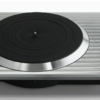IEEE websites place cookies on your device to give you the best user experience. By using our websites, you agree to the placement of these cookies. To learn more, read our Privacy Policy.
The direct-drive turntable is the only music-playback device to become a musical instrument itself. In this role, the turntables were an essential element in the development of hip-hop, the most popular and enduring new musical genre in the last 50 years. And there was one specific model that was overwhelmingly used in early hip-hop: the Technics SL-1200.
It was a surprising twist in the long history of recorded sound. Of his many inventions, Thomas Edison liked the phonograph best. His original machine, built in 1877, recorded on cylindrical media. Then in 1892, Emile Berliner began commercializing disk-shaped records. The overwhelming success of the platter format led to a complete takeover of the market by turntables. Many of the first models relied on cranks and flywheels to spin discs at a consistent speed. To spin the platter, some of the early machines used idler-wheel drives: the motor spun the idler wheel, and the idler wheel turned the platter. Belt drives were the next step (and opinions vary as to whether the step was forward or backward).
Turntable manufacturers understood that it could be advantageous to dispense with belts, which weren’t ideal for maintaining a consistent spin rate and were also prone to failure. Some tinkered with direct-drive turntables, but a direct-drive would require very precise control of motor acceleration and speed, and achieving that in a mass-market record player remained impractical for decades.
Electronics finally provided the means. The first electronic direct-drive turntable, the SP10, was designed by Shuichi Obata, an engineer with Matsushita’s Technics division. It hit the market in 1969 (MoMA has one in its permanent collection). The SL-1200, also designed by Obata, came three years and a few product models later.
Direct-drive turntables have high torque, which means that, among other things, they spin up to speed almost instantaneously. They also tend to be superior when it comes to maintaining a constant speed, virtually eliminating wow and flutter—audible pitch variations that occur because the record is being rotated at an inconstant rate. By the early 1970s, radio disk jockeys, club DJs, and recording engineers had started adopting direct-drives.
The issue was not just the sound. Direct-drives were attractive because they could be manually manipulated without damaging them, an issue of paramount importance to DJs. On a belt drive, playing a record from a standing start is dicey, because a belt-drive takes a frequently unpredictable amount of time to accelerate to the designated speed. If you place the needle in the record groove too close to the start of the song, the platter won’t be rotating fast enough when the music starts, and you get an off-pitch rev-up. Start the needle too far in advance and you get an awkward silence. So in that belt era, DJs developed a technique called the slip cue. They would find the beginning of the song on the record, back up a fraction of a rotation, and leave the needle in that spot while manually holding the record platter motionless on a spinning turntable surfaced with a felt mat. The instant they wanted to start the song, they released the record. Cuing a song correctly with that technique was an issue of professional pride for DJs back when they still spun records, because a) it sounded good, and b) if not done adeptly, it could cause wear and tear on the belt-drive mechanism.
Because direct-drive turntables have such superior torque, slip-cuing works better on them. Spinning them backwards—a no-no with belt drives—is not a problem. For DJs, that feature meant they could quickly and easily spin a record backward to find a cue.
Regardless of whether working for a radio station or a club, any DJ has at least two turntables. Ordinarily, the only time they’d both be playing audibly was during the segue from one to the other. However, in the early 1970s, some club DJs began experimenting with keeping both turntables live and while one was playing, they’d cue the other aloud over the speakers, sometimes so rapidly the distorted sounds were in time with the beat of the music coming from the other turntable. That technique, called scratching, quickly became the signature sound of early hip-hop. Scratching was impossible on belt drives, because it would destroy them.
The turntable of choice for years was the SL-1200. Having direct-drive turntables was essential, and Technics had the prestige of being first to the market. It also helped that the SL-1200 was readily available and rugged enough to throw in a van and haul to a party hours away.
The SL-1200 product line remained in production for 38 years, starting in 1972. Technics kept making them long after CDs had elbowed aside vinyl records and even after streaming had started elbowing aside CDs. Eventually, declining sales finally forced the company to discontinue the line, in 2010. Then something unexpected happened: a small but sustained revival of the LP format. Technics resumed manufacturing SL-1200s in 2016.
Your weekly selection of awesome robot videos
Evan Ackerman is a senior editor at IEEE Spectrum. Since 2007, he has written over 6,000 articles on robotics and technology. He has a degree in Martian geology and is excellent at playing bagpipes.
Video Friday is your weekly selection of awesome robotics videos, collected by your friends at IEEE Spectrum robotics. We also post a weekly calendar of upcoming robotics events for the next few months. Please send us your events for inclusion.
Enjoy today’s videos!
[ Dronisos ]
There’s a new Mini Pupper on Kickstarter, now with ROS 2!
[ Kickstarter ]
Paper at IROS next week!
[ MIT CSAIL ]
Thanks, Rachel!
[ Natural Robotics Contest ]
Thanks, Rob!
I’ve never seen a real centaur climb up onto a block while carrying a payload, but I bet it would look almost exactly like Centauro doing it.
[ Paper ]
Thanks, Ioannis!
That last clip is especially impressive, since if you look closely, you can see the drone avoiding a wire while flying directly toward the setting sun.
[ Skydio ]
Somehow I missed this adorable little robot of questionable usefulness from Sony.
[ Sony ]
[ Boston Dynamics ]
Awawa, awawa…
[ ICD Lab ]
Ascento, on patrol.
[ Ascento Robotics ]
Here’s what happens if you grab a Wing delivery drone’s cable and start running.
[ Wing ]
[ Boston Dynamics ]
[ Robotnik ]
How many robot dogs does it take to explore a football field? Fewer than it would if they weren’t working together, that’s for sure.
[ Deep Robotics ]
[ Oxford ]
Lex Fridman interviews Kate Darling.
[ Lex Fridman ]
In this week’s CMU RI Seminar, Nidhi Kalra from The RAND Corporation answers the question, “What (else) can you do with a robotics degree?”
[ CMU RI ]
He developed the first high-speed router 40 years ago
Daniel P. Dern is a freelance journalist. He writes about the careers of engineers as well as a variety of technology topics.
IEEE Fellow Craig Partridge, chair of the department of computer science at Colorado State University led the team that designed and built the world’s first high-speed router.
For computer pioneerCraig Partridge, pushing the envelope on interesting challenges has been his modus operandi. It’s what led him to make key contributions to the early Internet. Today he’s working on getting a better understanding of traffic flows in VPNs. In addition, he is trying to figure out what causes high rates of packet errors, which often result in bad file transfers, and how to fix them.
Although his bachelor’s degree from Harvard was in history, the computer electives he took convinced him he had both the aptitude and interest for a career in computing. And he was right. He focused on networking concepts and technologies while working at the ARPAnet and Internet pioneering firm Bolt Beranek & Newman (BBN), now Raytheon BBN Technologies.
There, the IEEE Fellow collaborated with TCP/IP developer Phil Karn on TCP message round-trip time estimation. Partridge also led the team that designed and built the world’s first high-speed router.
“It was 1983, and BBN needed an additional person who could write TCP/IP code for the BSD [Berkeley Software Distribution] Unix operating system,” he says. “BBN had folks who wrote most of the original code, and they taught me what networking and TCP/IP was. That was something no grad school at the time could teach me.
“A lot of what I worked on 30 or more years ago is still used today,” Partridge notes proudly. “More generally, a lot of the Internet tech used today is entirely or almost entirely recognizable from what was created back then. That’s a very pleasant feeling.”
Partridge is an Internet Hall of Fame inductee for his work in designing how email is routed using domain names.
While working at BBN, he went on to earn a master’s and Ph.D. in computer science, both from Harvard. By 2018 Partridge was chief scientist for networking research at BBN, but he decided he didn’t want his tenure there to be the last chapter of his career. Later that year he joined Colorado State University in Fort Collins, as chair of its department of computer science.
Partridge says it’s not uncommon for engineers to move from industry to academia later in their careers. They often want to “give back” by becoming professors, deans, or department chairs.
One of his assignments at CSU was to reexamine the school’s computer science curriculum. Among other improvements, the faculty now teaches courses in machine learning earlier. Virtual reality and virtual spaces courses were created, and the math requirements were revamped.
Partridge says during the mid-1980s he became aware of some of the challenges that women face in computing careers. “At BBN, at one point, my project leader, my boss, and my boss’s vice president were all women,” he recalls. “A number of women in computing at the time commented to me how rare that was. It opened my eyes.
“So in 1987 when I was looking to shift from industry to academia, I made it clear in my interviews at various universities that one of my goals was to look for ways to leverage what I had seen and learned, to help bring more women into computing.”
“Our focus at Colorado State is on the students already on campus. We encourage them to apply to computer science. We are also improving our curriculum by following the BRAID (Building, Recruiting, and Inclusion for Diversity) principles.”
He says this effort has included figuring out how to make the introductory courses speak to a wider variety of students by covering the same material but using different examples and different presentations that relate to how they could use computing to solve problems that interest them.
“We are trying to get them to understand that just because you can create something new doesn’t mean that society wants it,” he says. “You must create it in a way that is more likely to benefit society.”
In the four years since introducing these changes, Partridge says about half the students taking the introductory courses are women, and the number of women majoring in computing has nearly doubled, from 12 percent to more than 20 percent.
Partridge also has continued to conduct research, which he finds very different from how he did research at BBN.
“You are trying to do research while trying to teach the students,” he says. “You could often do the research faster yourself, but then the student wouldn’t learn. By comparison, in industry I knew I had a team I could give a broad description to and get the right thing the first time. With students, by the time they get good at it, they are graduating.”
In 2011, in response to a decade-old request from IEEE Spectrum columnist and IEEE Fellow Robert Lucky for a list of open research questions in networking, Partridge published “Forty Data Communications Research Questions” in ACM’s Computer Communication Review.
Many of these questions remain as concerns. For example, one of his graduate students studied packet errors and discovered that checksums, which are used to detect corruption in the header of IPv4 packets, are bad at detecting certain kinds of errors that are likely to occur over asynchronous transfer mode.
“We are using that kind of experience again today to find the next generation of packet errors in data centers,” Partridge says.
He would like today’s engineers to pay more attention to edge computing, smart home infrastructure, vehicle safety systems, and walled-garden social networks, such as Instagram and Twitter. He says walled gardens are “social networks where people don't want to connect to people who don't want to connect with those who think differently.”
One challenge in preparing students for the world they will be working in, he says, “is getting them to understand that just because you can create something new doesn’t mean that society wants it.”
This article appears in the November 2022 print issue as “Craig Partridge.”
Learn how to measure and reduce common mode electromagnetic interference (EMI) in electric drive installations
Nowadays, electric machines are often driven by power electronic converters. Even though the use of converters brings with it a variety of advantages, common mode (CM) signals are a frequent problem in many installations. Common mode voltages induced by the converter drive common mode currents damage the motor bearings over time and significantly reduce the lifetime of the drive.
Download this free whitepaper now!
Hence, it’s essential to measure these common mode quantities in order to take suitable countermeasures. Handheld oscilloscopes in combination with Rogowski probes offer a simple and reliable way to accurately determine the required quantities and the effectiveness of different countermeasures.







